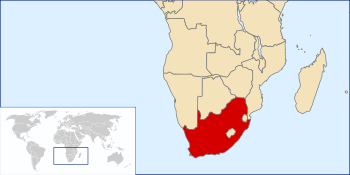Ossewabrandwag
The Ossewabrandwag (OB) (Afrikaans: Ossewabrandwag, from Afrikaans: ossewa, lit. 'ox-wagon' and Afrikaans: brandwag, lit. 'guard, picket, sentinel, sentry' - Ox-wagon Sentinel) was an anti-British and pro-German organisation in South Africa during World War II, which opposed South African participation in the war. Pro-German Afrikaners formed the Ossewabrandwag in Bloemfontein on 4 February 1939.
 Seal of the Ossewabrandwag | |
 | |
| Motto | My God. My Volk. My land Suid-Afrika. (Afrikaans for 'My God. My People. My country South Africa.') |
|---|---|
| Formation | 4 February 1939 |
| Extinction | 1952 |
| Purpose | Afrikaner nationalism Pro-German Anti-British Opposition to participation in World War II |
| Headquarters | Bloemfontein, Union of South Africa |
Leader | Johannes Van Rensburg |
Background
During the 19th century, most of the Boers of the northeastern Cape frontier migrated to the interior, and established the Orange Free State and South African Republic, which were independent of Britain. In the Second Boer War (1899–1902), Britain conquered the Boer Republics. The Netherlands (and Germany) supported the Boer cause.
After the war, there was a general reconciliation between Afrikaners and Britain, culminating in the formation of the Union of South Africa in 1910, under the leadership of former Boer fighters such as Louis Botha and Jan Smuts. South African troops, including thousands of Afrikaners, served in the British forces during World War I.
Nonetheless, many Boers remembered the tactics used by Britain in the Second Boer War and remained resentful of British rule, even loose association with Britain as a Dominion.
1930s
The chief vehicle of Afrikaner nationalism at this time was the "Purified National Party" of D. F. Malan, which broke away from the National Party when the latter merged with Smuts' South African Party in 1934. Another important element was the Afrikaner Broederbond, a quasi-secret society founded in 1918, and dedicated to the proposition that "the Afrikaner volk has been planted in this country by the Hand of God..."[1]
1938 was the centennial anniversary of the Great Trek (the migration of Boers to the interior). The Ossewabrandwag was established in commemoration of the Trek. Most of the migrants travelled in ox-drawn wagons, hence the group's name. The group's leader was Johannes Van Rensburg, a lawyer who had served as Secretary of Justice under Smuts (as Minister), and was an admirer of Nazi Germany.[2][3]
During World War II
The Boer militants of the Ossebrandwag (OB) were hostile to Britain and sympathetic to Germany. Thus the OB opposed South African participation in the war, even after the Union declared war in support of Britain in September 1939. While there were parallels, neither Van Rensburg nor the OB were genuine fascists, according to van den Berghe.[4]
Alexandre Kum'a Ndumbe III, however shows, that OB was "based on the Führer-principle, fighting against the Empire, the capitalists, the communists, the Jews, the party and the system of parliamentarism... on the base of national-socialism" according to a German secret source dated 18 January 1944[lower-alpha 1]
Members of the OB refused to enlist in the South African forces and sometimes harassed servicemen in uniform. That erupted into open rioting in Johannesburg on 1 February 1941; 140 soldiers were seriously hurt.[5]
More dangerous was the formation of the Stormjaers (Assault troops), a paramilitary wing of the OB. The nature of the Stormjaers was evidenced by the oath sworn by new recruits: "If I retreat, shoot me. If I die, avenge me. If I advance, follow me" (Afrikaans: As ek omdraai, skiet my. As ek val, wreek my. As ek storm, volg my).[6]
The Stormjaers engaged in sabotage against the Union government. They dynamited electrical power lines and railroads and cut telegraph and telephone lines.[5] These types of acts were going too far for most Afrikaners, and Malan ordered the National Party to break with the OB in 1942.[2]
The Union government cracked down on the OB and the Stormjaers, placing thousands of them in internment camps for the duration of the war. Among the internees was future prime minister B. J. Vorster.
At the end of the war, the OB was absorbed into the National Party and ceased to exist as a separate body.
See also
References
- Author of this message named "Felix", i. e. Lothar Sittig, a German agent, who was based inside the South African Union and had frequent contact with Dr J. F. Johannes Van Rensburg, the Ossewabrandwag leader. pp. 7f.. See Unesco, 1980 p. 17 "O. B. im Jahreswechsel", i.e. Ossewabrandwag in the turn of the year. Print in French: A. Kum'a N'Dumbe, Hitler voulait l'Afrique, l'Harmattan, Paris 1980 ISBN 978-2-85802-140-6 pp. 371f; in German: IKO Verlag, Frankfurt 1993. – From: Auswärtiges Amt (Foreign Office) Bonn, Archives StS Afrika (i.e.: Staatssekretär) 1939 – 1943, f. 24, 1102-S9
- Schönteich, M; Boshoff, H (March 2003), 'Volk' Faith and Fatherland. The Security Threat Posed by the White Right, Institute of Security Studies Monographs
- "Ossewabrandwag" at About.com, Alistair Boddy-Evans
- Marx, Christoph (2009). Oxwagon Sentinel: Radical Afrikaner Nationalism and the History of the 'Ossewabrandwag'. Münster: LIT. ISBN 978-3-8258-9797-0.
- Van den Berghe, Pierre L. (1967). South Africa, a Study in Conflict. Berkeley: University of California Press. ISBN 978-0-520-01294-3.
- Bunting, Brian Percy (1969). "Ch 6". The rise of the South African Reich. Penguin Books.
- Williams, Basil (1946). "Ch 10 Smuts and the War in Africa". Botha Smuts And South Africa. London: Hodder and Stoughton. pp. 161–178.
